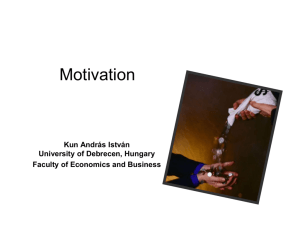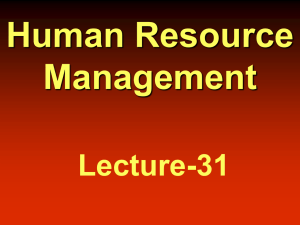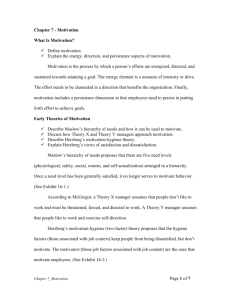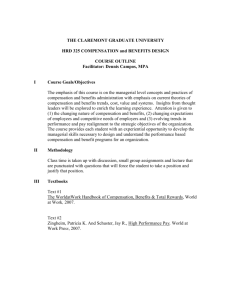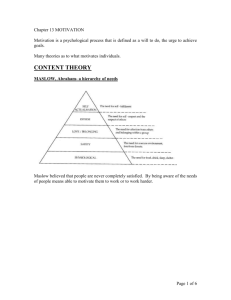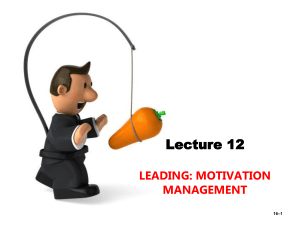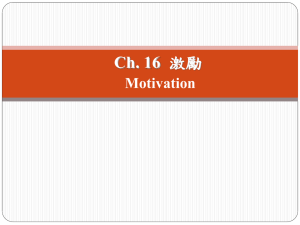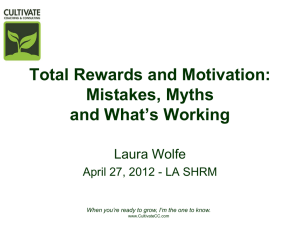The 3rd core management function: Leading
advertisement
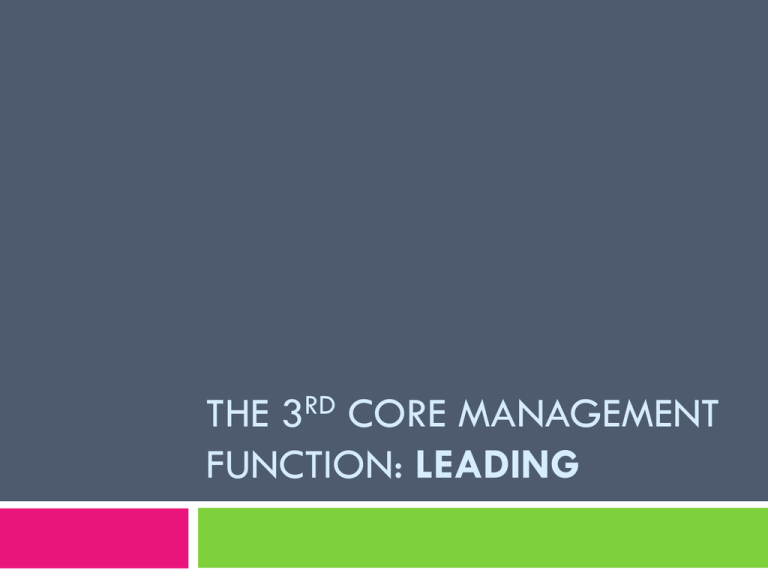
THE 3RD CORE MANAGEMENT FUNCTION: LEADING What is LEADING? Motivate subordinates(lower positions) Help resolve group conflicts Influence individuals or teams as they work Select the most effective communication channel Deal with employee behavior issues Leading Process Leadership Motivation Performance 5 Sources of Leader Power 1. 2. 3. 4. 5. Legitimate Power: influencing behavior because of one’s formal position Reward Power: influencing behavior by promising or giving rewards Coercive Power: influencing behavior by threatening or giving punishment Expert Power: influencing behavior because of one’s expertise Referent Power: influencing behavior because of one’s personal attraction What is MOTIVATION? The process by which a person’s efforts are energized, directed, and sustained toward attaining a goal The psychological processes that arouse and direct goal-directed behavior Motivation Model: People have certain needs that motivate them to perform specific behaviors for which they receive rewards that feed back and satisfy the original need Why is motivation important? You want to motivate people to… Join your organization Stay with your organization Show up for work at your organization: no absenteeism or lateness Perform better for your organization: high productivity Do extra for your organization: not only their duty but also be organizational “good citizens” Motivation Theories III. Maslow’s Hierarchy of Needs McGregor’s Theory X and Theory Y Herzberg’s Two-Factor Theory IV. McClelland’s Three-Needs Theory I. II. I. Maslow’s Hierarchy of Needs: 5 Levels Higherorder needs = internal Lowerorder needs = external 5 Levels of Needs 1. 2. 3. 4. 5. Physiological Needs: the most basic human physical needs, in which one is concerned with having food, clothing, shelter, and comfort and with self-preservation Safety Needs: concern with physical safety and emotional security, so that a person is concerned with avoiding violence and threats Belongingness Needs: once basic needs and security are taken care of, people look for love, friendship, and affection Esteem Needs: after they meet their social needs, people focus on such matters as self-respect, status, reputation, recognition, and self-confidence Self-Actualization Needs: it is self-fulfillment—the need to develop one’s fullest potential, to become the best one is capable of being Organization fulfills employee’s need by… Offer training, creativity, promotions, employee control over jobs Offer recognition, status, challenges, merit pay, employee participation in making decisions Offer interaction with others, participation in workgroup, good relations with supervisors Offer safe working conditions, job security, health and retirement benefits Offer adequate ventilation, heat, water, base pay II. McGregor’s Theory X and Theory Y It should guide management practice which would maximize employee motivation Theory X: negative view of people such as workers have little ambition, dislike work, want to avoid responsibility, need to be closely controlled to work effectively Theory Y: positive view of people such as workers enjoy work, seek out and accept responsibility, exercise selfdirection III. Herzberg’s Two-Factor Theory: From Dissatisfying Factors to Satisfying Factors Also called “motivation-hygiene theory” This theory proposed that work satisfaction and dissatisfaction arise from 2 different factors: motivating factors (motivators)— “What will make my people satisfied?” The higher-level needs or simply motivators are factors associated with job satisfaction—such as achievement, recognition, responsibility, and advancement—all of which affect the job content or the rewards of work performance hygiene factors—“Why are my people dissatisfied?” The lower-level needs are factors associated with job dissatisfaction—such as salary, working conditions, interpersonal relationships, and company policy—all of which affect the job context in which people work Satisfaction vs. Dissatisfaction IV. McClelland’s Three-Needs Theory: Achievement, Affiliation, and Power 3 needs—achievement, affiliation, and power—are major motives determining people’s behavior in the workplace 3 needs are as follows: Need for achievement– “I need to excel at task”: the desire to do something better or more efficiently, to solve problems, to achieve excellence in challenging tasks Need for affiliation– “I need close relationships”: the desire for friendly and warm relations with other people Need for power– “I need to control others”: the desire to be responsible for other people to influence their behavior or to control them Fitting Jobs to People Techniques (Job Design) Job Enlargement: putting variety into a job • • It consists of increasing the number of tasks in a job to increase variety and motivation This increases job scope which expand scope of knowledge Job Enrichment: putting more responsibility & other motivating factors into a job • • It consists of building into a job such motivating factors as responsibility, achievement, recognition, stimulating work, and advancement This increases job depth which enable more employee’s empowerment Motivation & Compensation Characteristics of the best incentive compensation plans: Rewards must be linked to performance and be measurable Rewards must be agreed on by manager and employees Rewards must be perceived as being equitable, believable, and achievable by employees Motivation & Compensation Popular incentive compensation plans: Pay for performance (merit pay): it bases pay on one’s results, according to measurable criteria Bonuses: they are cash awards given to employees who achieve specific performance objectives Profit sharing: the distribution to employees of a percentage of the company’s profits (profitability measure) Gainsharing: the distribution of savings or “gains” to groups of employees who reduced costs and increased measurable productivity (productivity measure) Stock options: with stock options, certain employees are given the right to buy stock at the future date for a discounted price Pay for knowledge (skill-based pay): it ties employee pay to number of job-relevant skills or academic degrees they earn Nonmonetary Ways of Motivating Employees Thoughtfulness: the value of being nice Work-life benefits Surroundings Skill-building & educational opportunities Sabbaticals (leave)

